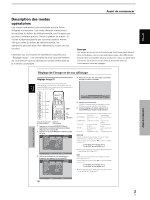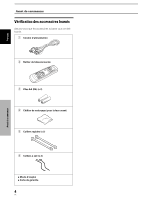Pioneer PRO-810HD Owner's Manual - Page 59
Appendix 3, Explanation of Terms
 |
View all Pioneer PRO-810HD manuals
Add to My Manuals
Save this manual to your list of manuals |
Page 59 highlights
English Appendix 3 INPUT1 (Mini D-sub 15 pin female connector) pin allocation. 51 Pin No. 1 2 3 4 5 6 7 8 9 10 11 12 13 14 15 10 6 15 11 Input R G B NC (No connection) GND GND GND GND DDC + 5V GND NC (No connection) DDC SDA HD or H/V SYNC VD DDC SCL Additional Information Component video signal General term for video signal format composed of the Y.CBCR, Y.PBPR and Y.B-Y.R-Y luminance signal + color signal. The component video signal is sometimes simply called the color difference signal. G ON SYNC This indicates a video signal in the form of a synchronization signal added to the G (GREEN) signal of the RGB signal. VGA General term for Video Graphics Array. Generally this indicates a 640 dot x 480 line resolution. WVGA General term for Wide Video Graphics Array. Generally this indicates a 848 dot x 480 line resolution. XGA General term for eXtended Graphics Array. Generally this indicates a 1024 dot x 768 line resolution. WXGA General term for Wide eXtended Graphics Array. Generally this indicates a 1280 dot x 768 line resolution. Additional Information Explanation of Terms Aspect ratio The TV screen's width to height ratio is referred to as its aspect ratio. The aspect ratio on standard TVs is 4:3 and on wide TVs or High Definition TVs it is 16:9. S jack (S-VIDEO jack) This jack separates and transmits the video signal as two signals; the luminance (Y) signal and the color (C) signal. Because of this, picture reproduction is superior to that obtained at the composite input/output jacks. S-video signal The video signal is composed of two signals; the chroma signal (color signal) which reproduces color and the luminance signal which reproduces light and darkness. With standard video components, these two signals are combined into one and are handled as a video signal referred to as the composite signal. The S-video signal, however, is a signal that handles these two signals separately. Because they are not combined as in the composite video signal, the high quality of both signals can be retained. Published by Pioneer Corporation. Copyright © 2004 Pioneer Corporation. All rights reserved. 55 EN















